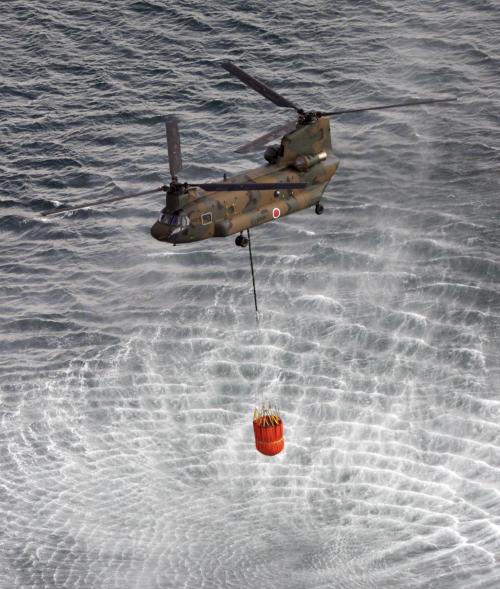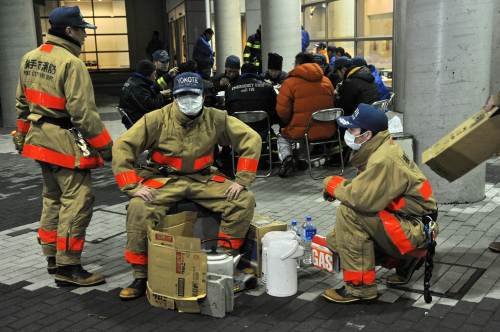FUKUSHIMA, Japan (AP) _ They risk explosions, fire and an invisible enemy _ radiation that could kill quickly or decades later_ as they race to avert disaster inside a dark, overheated nuclear plant.
The 180 emergency workers at Japan's crippled Fukushima Dai-ichi complex are emerging as public heroes in the wake of a disaster spawned by an earthquake and a tsunami.

Dubbed by some as modern-day samurai, the technicians were back at work late Wednesday after a surge of radiation forced them to leave their posts for hours.
``I don't know any other way to say it, but this is like suicide fighters in a war,'' said Keiichi Nakagawa, associate professor of the Department of Radiology at the University of Tokyo Hospital.
Small teams of the still-anonymous emergency workers rush in and out for 10 to 15 minutes at a time to pump sea water into the plant's overheated reactors, monitor them and clear debris from explosions. Any longer would make their exposure to radioactivity too great. They also struggle with broken equipment and a lack of electricity.

Even at normal times, workers wear coveralls, full-face masks with filters, helmets and double-layer gloves when they enter areas with a possibility of radiation exposure. Some of them carry oxygen tanks so they don't have to inhale any radioactive particles into their lungs.
But the burst of radioactivity Wednesday led the government to order an evacuation of the Dai-ichi complex for about five hours.
``The workers cannot carry out even minimal work at the plant now,'' Chief Cabinet Secretary Yukio Edano said of the evacuation.
The highest reading among various locations that had to be accessed by the workers hit 600 millisieverts, equal to several years of daily exposure limit, according to statistics released by Tokyo Electric Power Company.
Millisieverts measure exposure to radiation, which can cause cancer and birth defects. Severe exposure can cause burns and radiation sickness _ nausea and vomiting and harm to blood cells.
A typical individual might absorb 6 millisieverts a year from natural and manmade sources such as X-rays. Small additional annual exposures of under 100 millisieverts are believed to produce no discernible harm but more carries health risks.
Tony Irwin, an Australian-based nuclear consultant, said the normal dose for a radiation worker is 20 millisieverts a year, averaged over five years, with a maximum of 50 millisieverts in any one year.
``So they would be trying to rotate people to make sure they're within that limit. Now many countries have an emergency limit of 100 msvs a year,'' he said. ``They'll wear radiation monitors, so they can see exactly what they're getting on a real time basis.''
Yet on Wednesday, Japan's Ministry of Health Labor and Welfare raised the maximum legal exposure for nuclear workers to 250 millisieverts from 100 millisieverts. It described the move as ``unavoidable due to the circumstances.''
The workers' challenges this week have included struggling for hours to open a pressure-release valve and allow water to enter the reactors. When a worker left the scene for a short period, the water flow ceased and fuel for pumps bringing up the water ran out.
A building housing a spent fuel storage pool exploded Tuesday, making two huge holes on the upper side of the wall on the building.
A plant worker spotted a fire shortly thereafter that was later put out.
The workers also have had to walk around the area to measure radioactivity in each place where they were supposed to enter, and remove contaminated debris.
``Workers persevere amid fears of 400 millisieverts,'' read one headline in the nationally circulated Yomiuri newspaper.
The newspaper said one male worker who was opening a valve to let out built-up steam was hospitalized after complaining of nausea and exhaustion after being exposed for 10 minutes of radiation, despite wearing head-to-toe protective gear and a mask.
``The thing I've been concerned about right now are the workers. They are at a tremendous risk,'' said Don Milton, a doctor who specializes in occupational health and directs the Maryland Institute of Applied Environmental Health at the University of Maryland.
Milton noted reports that some workers have already shown signs of acute radiation sickness. That would be even worse than it sounds because ``the sooner it comes on after exposure, the worse it is.''
<관련 기사>
<日대지진> 정년 앞둔 원전기술자, 후쿠시마로
"원전의 미래가 달려있다"며 특별지원팀 합류
후쿠시마(福島) 제1원자력발전소에서 발생한 폭발사고로 정부의 뒤늦은 대응에 비판의 목소리가 높아지고 있는 가운데, 최악의 사태를 막기 위해 몸을 던져 사고처리 작업에 나서고 있는 사람들이 주목을 받고 있다.
CNN 인터넷판은 이들을 가리켜 "소수의 영웅들이 원전을 지키기 위해 싸우고 있다"며 치켜세웠다.
이런 가운데 지방의 한 전력회사에 근무하는 59세 남성이 정년을 불과 6개월 남긴 채 후쿠시마 원전이 긴급 요청한 특별지원팀에 합류해 일본 국민들의 갈채를 받고 있다고 지지통신이 16일 보도했다.
지지통신에 따르면, 그는 40여년동안 원전에서 근무했으며 올해 9월에 정년퇴직할 예정이었다. 하지만 후쿠시마 원전 사고로 방사능 누출에 대한 우려가 높아지자 20여명을 모집하는 특별지원팀에 지체없이 몸을 던졌다.
그는 지난 13일, "지금 어떻게 대응하는냐에 따라 원전의 미래가 바뀐다"며 "사명감을 가지고 다녀 오겠다"고 가족에게 후쿠시마행을 알렸다. 이 이야기를 들은 딸(27)은 "집에서는 별로 말도 안하고, 미덥지 못할 때도 있는 아버지가 너무 자랑스러워 눈물이 나올 것 같았다"고 말했다.
후쿠시마로 향한 지난 15일 아침, 그는 평소와 다름없이 집을 나섰다. 딸도 특별한 배웅없이 평소처럼 출근했다. 그녀는 "처음에는 가지 말았으면 했지만, 만약 무슨 일이 있더라도 아버지 스스로 정한 것이라면 후회하지 않으실 거라고 생각했다"며 무사귀환을 당부했다.
그의 부인(58)는 "남편은 18세부터 지금까지 원전에 종사해왔다"며 "가장 안전한 일을 하고 있다는 자신감이 있어 (지원을 결심했을 거라고) 생각한다"고 말했다.
그녀는 남편을 보내며 "현지 사람들을 안심시킬 수 있게 열심히 하고 오세요"라는 말을 건냈다.
(연합뉴스)
<日대지진> 정년 앞둔 원전기술자, 후쿠시마로
"원전의 미래가 달려있다"며 특별지원팀 합류
후쿠시마(福島) 제1원자력발전소에서 발생한 폭발사고로 정부의 뒤늦은 대응에 비판의 목소리가 높아지고 있는 가운데, 최악의 사태를 막기 위해 몸을 던져 사고처리 작업에 나서고 있는 사람들이 주목을 받고 있다.
CNN 인터넷판은 이들을 가리켜 "소수의 영웅들이 원전을 지키기 위해 싸우고 있다"며 치켜세웠다.
이런 가운데 지방의 한 전력회사에 근무하는 59세 남성이 정년을 불과 6개월 남긴 채 후쿠시마 원전이 긴급 요청한 특별지원팀에 합류해 일본 국민들의 갈채를 받고 있다고 지지통신이 16일 보도했다.
지지통신에 따르면, 그는 40여년동안 원전에서 근무했으며 올해 9월에 정년퇴직할 예정이었다. 하지만 후쿠시마 원전 사고로 방사능 누출에 대한 우려가 높아지자 20여명을 모집하는 특별지원팀에 지체없이 몸을 던졌다.
그는 지난 13일, "지금 어떻게 대응하는냐에 따라 원전의 미래가 바뀐다"며 "사명감을 가지고 다녀 오겠다"고 가족에게 후쿠시마행을 알렸다. 이 이야기를 들은 딸(27)은 "집에서는 별로 말도 안하고, 미덥지 못할 때도 있는 아버지가 너무 자랑스러워 눈물이 나올 것 같았다"고 말했다.
후쿠시마로 향한 지난 15일 아침, 그는 평소와 다름없이 집을 나섰다. 딸도 특별한 배웅없이 평소처럼 출근했다. 그녀는 "처음에는 가지 말았으면 했지만, 만약 무슨 일이 있더라도 아버지 스스로 정한 것이라면 후회하지 않으실 거라고 생각했다"며 무사귀환을 당부했다.
그의 부인(58)는 "남편은 18세부터 지금까지 원전에 종사해왔다"며 "가장 안전한 일을 하고 있다는 자신감이 있어 (지원을 결심했을 거라고) 생각한다"고 말했다.
그녀는 남편을 보내며 "현지 사람들을 안심시킬 수 있게 열심히 하고 오세요"라는 말을 건냈다.
(연합뉴스)









![[Hello India] Hyundai Motor vows to boost 'clean mobility' in India](http://res.heraldm.com/phpwas/restmb_idxmake.php?idx=644&simg=/content/image/2024/04/25/20240425050672_0.jpg&u=)








